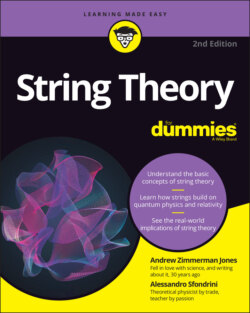Читать книгу String Theory For Dummies - Andrew Zimmerman Jones - Страница 59
The universe doesn’t have enough particles
ОглавлениеFor the mathematics of string theory to work, physicists have to assume a symmetry in nature called supersymmetry, which creates a correspondence between different types of particles. One problem with this is that instead of the 25 fundamental particles in the Standard Model, supersymmetry requires at least 36 fundamental particles (which means that nature allows 25 more particles that scientists have never seen!). In some ways, string theory does make things simpler — the fundamental objects are strings and branes or, as predicted by matrix theory, 0-dimensional branes called partons. These strings, branes, or possibly partons make up the particles that physicists have observed (or the ones they hope to observe). But that’s on a very fundamental level; from a practical standpoint, string theory doubles the number of particles allowed by nature from 25 to 50.
One of the biggest possible successes for string theory would be to experimentally detect these missing supersymmetric partner particles. Many theoretical physicists hoped that when the Large Hadron Collider particle accelerator at the European Organization for Nuclear Research in Switzerland went online, it would detect supersymmetric particles. This hasn’t happened — yet.
Even if it’s found, proof of supersymmetry doesn’t inherently prove string theory, so the debate would continue to rage on, but at least one major objection would be removed. Supersymmetry might well end up being true, whether or not string theory as a whole is shown to accurately describe nature.
